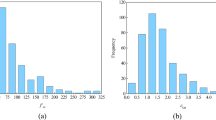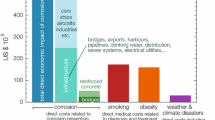Abstract
Concrete is undoubtedly the most important and widely used construction material of the late twentieth century. Yet, mathematical models that can accurately capture the particular material behavior under all loading conditions of significance are scarce at best. Although concepts and suitable models have existed for quite a while, their practical significance is low due to the limited attention to calibration and validation requirements and the scarcity of robust, transparent and comprehensive methods to perform such tasks. In addition, issues such as computational cost, difficulties associated with calculating the response of highly nonlinear systems, and, most importantly, lack of comprehensive experimental data sets have hampered progress in this area. This paper attempts to promote the use of advanced concrete models by (a) providing an overview of required tests and data preparation techniques; and (b) making a comprehensive set of concrete test data, cast from the same batch, available for model development, calibration, and validation. Data included in the database ‘http://www.baunat.boku.ac.at/cd-labor/downloads/versuchsdaten’ comprise flexure tests of four sizes, direct tension tests, confined and unconfined compression tests, Brazilian splitting tests of five sizes, and loading and unloading data. For all specimen sets the nominal stress–strain curves and crack patterns are provided.















Similar content being viewed by others
References
Wille K, Naaman AE, El-Tawil S, Parra-Montesinos GJ (2012) Ultra-high performance concrete and fiber reinforced concrete: achieving strength and ductility without heat curing. Mater Struct 45:309–324
Naik TR, Kumar R, Ramme BW, Canpolat F (2012) Development of high-strength, economical self-consolidating concrete. Constr Build Mater 30:463–469
Fantilli AP, Vallini P, Chiaia B (2011) Ductility of fiber-reinforced self-consolidating concrete under multi-axial compression. Cem Concr Compos 33(4):520–527
Wang H, Belarbi A (2011) Ductility characteristics of fiber-reinforced-concrete beams reinforced with FRP rebars. Constr Build Mater 25(5):2391–2401
Yang E-H, Li VC (2012) Tailoring engineered cementitious composites for impact resistance. Cem Concr Res 42(8):1066–1071
Hillerborg A, Modéer M, Petersson PE (1976) Analysis of crack formation and crack growth in concrete by means of fracture mechanics and finite elements. Cem Concr Res 6:773–782
Hillerborg A (1985) The theoretical basis of a method to determine the fracture energy \({G}_f\) of concrete. Mater Struct 18(4):291–296
Bažant ZP, Planas J (1998) Fracture and size effect in concrete and other quasibrittle materials. CRC Press, Boca Raton
Irwin GR (1958) Fracture, vol VI of Encyclopaedia of physics. Springer, Berlin
Hilsdorf HK, Lorman WR, Monfore GE (1973) Triaxial testing of nonreinforced concrete specimens. J Test Eval 1(4):330–335
Bažant ZP, Bishop FC, Chang TP (1986) Confined compression tests of cement paste and concrete up to 300 Ksi. ACI J Proc 83(4):553–560
Gabet T, Malécot Y, Daudeville L (2008) Triaxial behaviour of concrete under high stresses: influence of the loading path on compaction and limit states. Cem Concr Res 38(3):403–412
Bažant ZP, Kim JJH, Brocca M (1999) Finite strain tube-squash test of concrete at high pressures and shear angles up to 70 degrees. ACI Mater J 96(5):580–592
Brocca M, Bažant ZP (2001) Microplane finite element analysis of tube-squash test of concrete with shear angles up to 70. Int J Numer Methods Eng 52(10):1165–1188
Jirásek M, Bažant ZP (2002) Inelastic analysis of structures. Wiley, London
Han D-J (2007) Plasticity for structural engineers. J. Ross Publishing, Fort Lauderdale
Bažant ZP, Cedolin L (1991) Stability of structures: elastic, inelastic, fracture and damage theories, 2nd edn. Oxford University Press, New York
Bittnar Z, Šejnoha J (1996) Numerical methods in structural mechanics. ASCE Publications, New York
Taylor GI (1938) Plastic strain in metals. J Inst Met 63:307–324
Lin TH (1968) Theory of inelastic structures. Wiley, New York
Bažant ZP, Byung HO (1985) Microplane model for progressive fracture of concrete and rock. J Eng Mech 111(4):559–582
Cusatis G, Zhou X (2013) High order microplane theory for quasi-brittle materials with multiple characteristic lengths. J Eng Mech 140(7):04014046
Bažant ZP, Ožbolt J (1992) Compression failure of quasibrittle material: nonlocal microplane model. J Eng Mech 118(3):540–556
Hasegawa T, Bažant ZP (1993) Nonlocal microplane concrete model with rate effect and load cycles. I: general formulation. J Mater Civ Eng 5(3):372–393
Caner FC, Bažant ZP (2012) Microplane model M7 for plain concrete: I. Formulation. J Eng Mech 139(12), 1724–1735
Di Luzio G, Cusatis G (2013) Solidification-microprestress-microplane (SMM) theory for concrete at early age: theory, validation and application. Int J Solids Struct 50(6):957–975
Cusatis G, Beghini A, Bažant ZP (2008) Spectral stiffness microplane model for quasibrittle composite laminates, part I: theory. J Appl Mech 75(2):021009–021009-9
Beghini A, Cusatis G, Bažant ZP (2008) Spectral stiffness microplane model for quasibrittle composite laminates, part II: calibration and validation. J Appl Mech 75(2):021010–021010
de Borst R, Gutirrez MA, Wells GN, Remmers JJC, Askes H (2004) Cohesive-zone models, higher-order continuum theories and reliability methods for computational failure analysis. Int J Numer Methods Eng 60(1):289–315
Jirásek M (1998) Nonlocal models for damage and fracture: comparison of approaches. Int J Solids Struct 35(31–32):4133–4145
Bažant ZP, Jirásek M (2002) Nonlocal integral formulations of plasticity and damage: survey of progress. J Eng Mech 128(11):1119–1149
Bažant ZP, Oh BH (1983) Crack band theory for fracture of concrete. Mater Struct 16:155–177
Needleman A, Tvergaard V (1987) An analysis of ductile rupture modes at a crack tip. J Mech Phys Solids 35(2):151–183
Moës N, Dolbow J, Belytschko T (1999) A finite element method for crack growth without remeshing. Int J Numer Methods Eng 46(1):131–150
Ortiz M, Pandolfi A (1999) Finite-deformation irreversible cohesive elements for three-dimensional crack-propagation analysis. Int J Numer Methods Eng 44(9):1267–1282
Rocco C, Guinea GV, Planas J, Elices M (2001) Review of the splitting-test standards from a fracture mechanics point of view. Cem Concr Res 31(1):73–82
Cusatis G, Bažant ZP, Cedolin L (2003) Confinement-shear lattice model for concrete damage in tension and compression: I. Theory. J Eng Mech 129:1439
Cusatis G, Bažant ZP, Cedolin L (2003) Confinement-shear lattice model for concrete damage in tension and compression: II. Computation and validation. J Eng Mech 129:1449
Cusatis G, Bažant ZP, Cedolin L (2006) Confinement-shear lattice CSL model for fracture propagation in concrete. Comput Methods Appl Mech Eng 195(52):7154–7171
Cusatis G (2011) Strain-rate effects on concrete behavior. Int J Impact Eng 38(4):162–170
Bažant ZP, Tabbara MR, Kazemi MT, Pijaudier-Cabot G (1990) Random particle model for fracture of aggregate or fiber composites. J Eng Mech 116(8):1686–1705
Lilliu G, van Mier JGM (2003) 3D lattice type fracture model for concrete. Eng Fract Mech 70:927–941
Yip M, Li Z, Liao B, Bolander JE (2006) Irregular lattice models of fracture of multiphase particulate materials. Int J Fract 140:113–124
Gianluca C, Hikaru N (2011) Discrete modeling of concrete materials and structures. Cem Concr Compos 33(9):865–866
Cusatis G, Mencarelli A, Pelessone D, Baylot J (2011) Lattice discrete particle model (LDPM) for failure behavior of concrete. II: calibration and validation. Cem Concr Compos 33(9):891–905
Cusatis G, Pelessone D, Mencarelli A (2011) Lattice discrete particle model (LDPM) for failure behavior of concrete. I: theory. Cem Concr Compos 33(9):881–890
Schauffert EA, Cusatis G (2011) Lattice discrete particle model for fiber-reinforced concrete. I: theory. J Eng Mech 138(7):826–833
Schauffert EA, Cusatis G, Pelessone D, O’Daniel J, Baylot J (2012) Lattice discrete particle model for fiber-reinforced concrete. II: tensile fracture and multiaxial loading behavior. J Eng Mech 138(7):834–841
Cusatis G (2013) The lattice discrete particle model (LDPM) for the numerical simulation of concrete behavior subject to penetration. Wiley, London, pp 369–387
Alnaggar M, Cusatis G, Di Luzio G (2013) Lattice discrete particle modeling (LDPM) of Alkali Silica reaction (ASR) deterioration of concrete structures. Cem Concr Compos 41:45–59
Kim KT, Zdeněk P, Bažant P, Yu Q (2013) Non-uniqueness of cohesive-crack stress-separation law of human and bovine bones and remedy by size effect tests. Int J Fract 181(1):67–81
Caner FC, Bažant ZP, Wendner R (2013) Microplane model M7f for fiber reinforced concrete. Eng Fract Mech 105:41–57
Hoover CG, Bažant ZP, Vorel J, Wendner R, Hubler MH (2013) Comprehensive concrete fracture tests: description and results. Eng Fract Mech 114:92–103
Morteza MHA, Kazemi MT, Nikbin IM, Amiri JV (2013) The effect of water to cement ratio on fracture parameters and brittleness of self-compacting concrete. Mater Des 50:267–276
ASTM (2010) C293: standard test method for flexural strength of concrete (using simple beam with center-point loading)
Grubbs FE (1969) Procedures for detecting outlying observations in samples. Technometrics 11(1):1–21
Stefansky W (1972) Rejecting outliers in factorial designs. Technometrics 14(2):469–479
Model code 2010—final draft, vol 1. Technical Report, fib, 2012
ACI (2008) 209.2R: guide for modeling and calculating shrinkage and creep in hardened concrete. Technical Report
Hoover CG, Bažant ZP (2013) Comprehensive concrete fracture tests: size effects of types 1 & 2, crack length effect and postpeak. Eng Fract Mech 110:281–289
Nakayama J (1965) Direct measurement of fracture energies of brittle heterogeneous materials. J Am Ceram Soc 48(11):583–587
Tattersall HG, Tappin G (1966) The work of fracture and its measurement in metals, ceramics and other materials. J Mater Sci 1(3):296–301
Concrete—part 1: specification, performance, production and conformity, 2000
Eurocode 2 (2004) Design of concrete structures, part 1–1: general rules and rules for buildings
ASTM (2012) C39: standard test method for compressive strength of cylindrical concrete specimens
Hoover CG, Bažant ZP (2014) Universal size-shape effect law based on comprehensive concrete fracture tests. J Eng Mech 140(3):473–479
Weibull W (1939) The phenomenon of rupture in solids, vol 153. Royal Swedish Institute of Engineering Research, Stockholm, pp 1–55
Le J-L, Bažant ZP, Bazant MZ (2011) Unified nano-mechanics based probabilistic theory of quasibrittle and brittle structures: I. Strength, static crack growth, lifetime and scaling. J Mech Phys Solids 59(7):1291–1321
Le J-L, Bažant ZP (2011) Unified nano-mechanics based probabilistic theory of quasibrittle and brittle structures: II. Fatigue crack growth, lifetime and scaling. J Mech Phys Solids 59(7):1322–1337
ASTM (2011) C496: standard test method for splitting tensile strength of cylindrical concrete specimens
CEN (2009) EN12390-6: testing hardened concrete
Rocco C, Guinea GV, Planas J, Elices M (1999) Size effect and boundary conditions in the Brazilian test: theoretical analysis. Mater Struct 32(6):437–444
Tang T (1994) Effects of load-distributed width on split tension of un-notched and notched cylindrical specimens. J Test Eval 22(5):401–409
Rocco C, Guinea GV, Planas J, Elices M (1999) Size effect and boundary conditions in the Brazilian test: experimental verification. Mater Struct 32(3):210–217
Bažant ZP, Kazemi MT, Hasegawa T, Mazars J (1991) Size effect in Brazilian split-cylinder tests. Measurements and fracture analysis. ACI Mater J 88(3):325–332
Acknowledgments
The financial support by the Austrian Federal Ministry of Economy, Family and Youth and the National Foundation for Research, Technology and Development for part of the analysis is gratefully acknowledged, as is the financial support from the U.S. Department of Transportation, provided through Grant No. 20778 from the Infrastructure Technology Institute of Northwestern University, for the initial size effect investigation. The work of G. Cusatis was supported under NSF Grant No. 0928448.
Author information
Authors and Affiliations
Corresponding author
Rights and permissions
About this article
Cite this article
Wendner, R., Vorel, J., Smith, J. et al. Characterization of concrete failure behavior: a comprehensive experimental database for the calibration and validation of concrete models. Mater Struct 48, 3603–3626 (2015). https://doi.org/10.1617/s11527-014-0426-0
Received:
Accepted:
Published:
Issue Date:
DOI: https://doi.org/10.1617/s11527-014-0426-0




